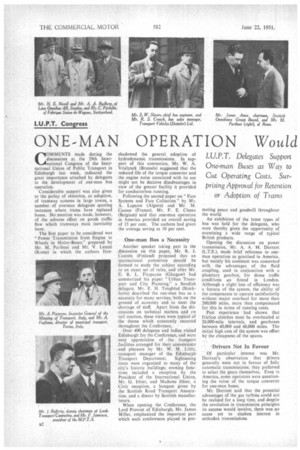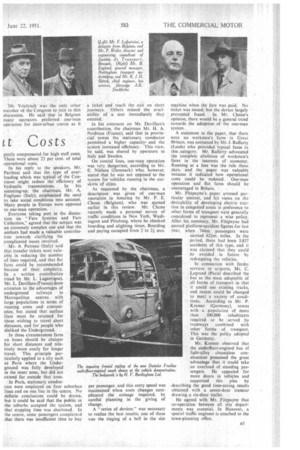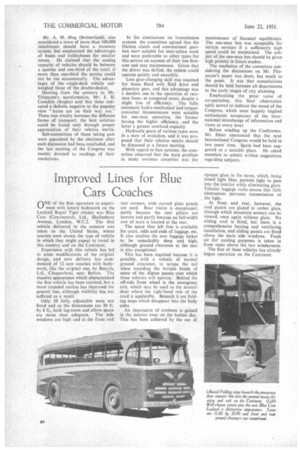ONE-MAN OPERATION Would t t Co s ts
Page 36

Page 37

Page 38

If you've noticed an error in this article please click here to report it so we can fix it.
Delegates Support One-man Buses as Way to Cut Operating Costs. Surprising Approval for Retention or Adoption of Trams
COMMENTS made during the discussions at the 29th International Congress of the International Union of Public Transport in Edinburgh last week, indicated the great importance attached by delegates to the development of one-man bus operation.
Considerable support was also given to the policy of retention, or adoption, of tramway systems in large towns, a number of overseas delegates quoting instances where trams have replaced buses. No mention was made, however, of the adverse effect on goods traffic flow which tramways must inevitably have.
The first paper to be considered was "Power Transmission from Engine to Wheels in Motor-Buses," prepared by Mr. M. Paribeni and Mr. V. Leuzzi (Rome) in which the authors fore shadowed the general adoption of hydrodynamic transmissions. In support of this contention, Mr. W. A. Vrielynck (Brussels) suggested that the reduced life of the torque converter and the engine noise associated with its use might not be decisive disadvantages in view of the greater facility it provided for conductorless running.
Following the second paper on "Fare Systems and Fare Collection" by Mr. A. Laparre (Algiers) and Mr. M. Cassan (France), Mr. F. E. Chenu (Belgium) said that one-man operation in America provided an overall saving of 15 per cent. The authors had given the average saving as 10 per cent.
One-man Bus a Necessity
Another speaker taking part in the discussion on this paper, Mr. R. J. Castren (Finland) proposed that an international committee should be formed to study the subject according to an exact set of rules, and after Mr. E. R. L. Fitzpayne (Glasgow) had summarized his paper "Urban Transport and City Planning," a Swedish delegate, Mr. E H. TengbIad (Stockholm) described the one-man bus as a necessity for many services, both on the ground of economy and to meet the shortage of staff. Apart from the discussions on technical matters and on rail traction, these views were typical of the theme which constantly recurred throughout the Conference.
Over 400 delegates and ladies visited Edinburgh for the Conference, and were ,very appreciative of the transport ,facilities arranged for their convenience and pleasure by Mr. W. M. Little, transport manager of the Edinburgh Transport Department. Sightseeing tours were organized to many of the city's historic buildings; evening functions included a reception by the President of the International Union, Mr. G. Ithier, and Madame Ithier, a Civic reception, a banquet given by the Scottish Road Transport Association, and a dinner by Scottish manufacturers.
When opening the Conference, the Lord Provost of Edinburgh, Mr. James Miller, emphasized the important part which such conferences played in pro
moting peace and goodwill throughout the world.
An exhibition of the latest types of bus was held for the delegates, who were thereby given the opportunity of examining a wide range of typical British products.
Opening the discussion on power transmission, Mr. A. A. M. Durrant (L.T.E.), made brief reference to oneman operation as practised in America, but mainly his comment was concerned with the advantages of the fluid coupling, used in conjunction with a planetary gearbox, for dense traffic conditions ,as found in London. Although a slight loss of efficiency was a feature of the system, the ability of the components to operate satisfactorily without major overhaul for more than 200,000 miles, more than compensated for this in terms of running costs.
Past experience had shown that friction clutches must be overhauled at 20,000-mile intervals, and gearboxes between 40,000 and 60,000 miles. The initial high cost of the system was offset by the cheapness of the spares.
• Drivers Not In Favour Of particular interest was Mr. Durrant's observation that drivers generally were not in favour of fully automatic transmissions; they preferred to select the gears themselves. Even in America, some operators were questioning the value of the torque converter for one-man buses.
Mr. Durrant said that the potential advantages of the gas turbine could not be realized for a long time, and despite the revolution in transmission principles its success would involve, there was no cause yet to slacken interest in orthodox transmissions.
partly compensated for high staff costs. These were about 25 per cent. of total operational costs. In his reply to the speakers, Mr. Paribeni said that the type of overloading which was typical of the Continent might reduce the efficiency of hydraulic transmissions. In his summing-up, the chairman, Mr; A. Fogliano (Italy), emphasized the need to take social conditions into account. Many people in Europe were opposed to one-man operation. Everyone taking part in the discussion on "Fare Systems and Fare Collection," agreed that the subject was an extremely complex one and that the authors had made a valuable contribution towards clarifying the complicated issues involved.
Mr. A. Patrassi (Italy) said that transfer tickets were valuable in reducingthe number of lines required, and that flat fares could be recommended because of their simplicity. In a written contribution (read by Mr. L. Lagarrigue), Mr. L. Devillers (France) drew attention to the advantages of underground railways in Metropolitan centres with large populations in terms of running costs and convenience, but stated that surface lines must be retained for those wishing to travel short distances, and for people who disliked the Underground.
In these circumstances fares on buses should be cheaper for short distances and relatively more costly for longer travel. This principle particularly applied to a city such as Paris where the Underground was fully developed in the inner zone, but did not extend far outside that zone.
In Paris, stationary conductors were employed on four suburban lines and on one line in the centre. No definite conclusions could be drawn, but it could be said that the public in the suburbs accepted the system, and that stopping time -was shortened. In the centre, some passengers complained that there was insufficient time to buy
a ticket and reach the exit on short journeys. Others missed the availability of a seat immediately they entered. •
In his comment on Mr. Dev-illers's contribution, the chairman Mr. H. A. Perdreau (France), said that in provincial towns the stationary conductor permitted a higher capacityand the system increased efficiency. This view, he said, was shared by operators in Italy and Sweden.
On central lines, one-man operation was very dangerous, according to Mr. E. Nielsen (Denmark) who, however, stated that he was not opposed to the system for vehicles running in the outskirts of cities.
As requested by the chairman, a description was given of one-man operation in America by Mr. F. E.
• Chenu (Belgium), who was quoted earlier in this review. Mr. Chenu recently made a personal survey of traffic conditions in New York, Washington and Pittsburg, where he checked boarding and alighting times. Boarding and paying occupied from 2 to secs.
per passenger, and this entry speed was maintained when costs changes complicated the coinage required, by careful planning in the giving of change.
A "series of devices" was necessary to realize the best results; one of these was the ringing of a bell in the slot machine when the fare was paid. No ticket was issued, but the device largely • prevented fraud. In Mr. Chenu's opinion, there would be a general trend towards the adoption of the one-man system.
A statement in the paper, that there were no workmen's fares in Great Britain, was corrected by Mr. J. Rafferty (Leeds) who provided typical fares in this category. Mr. Rafferty advocated the complete abolition of workmen's .fares in the interests of economy. Running at a loss was the rule these days, and the paper was valuable, because it indicated how operational costs could be reduced. One-man Operation and flat fares should be encouraged in Britain.
Mr. Fitzpayne's paper aroused particular interest, and his views, on the • desirability of developing electric traction in congested areas in preference to other forms of transport were generally considered to represent a wise policy. After his summary, Mr. Fitzpayne had quoted platform-accident-figures for last year, when 744m. passengers were carried 62-1-rn. miles. In the period, there had been 3,837 accidents of this type, and it was claimed that they could be avoided in future by redesigning the vehicles.
In connection with feeder services to airports, Mr. C. Legrand (Paris) described the bus as the most adaptable of all forms of transport in that it could use existing tracks, and routes could be changed to meet a variety of conditions. According to Mr. P. Kremer (Germany), towns with a population of more than 100,000 inhabitants required to be served by tramways combined with other forms of transport. This was the policy adopted in Germany.
Mr. Kremer observed that the underfloor-engined bus of light-alloy chassisless construction possessed the great advantage that it could take an overload of standing passengers'. He appealed for more doors in vehicles and supported this plea by .describing the good time-saving results obtained with a seven-door tramcar drawing a six-door trailer.
He agreed with Mr. Fitzpayne that co-operation between all city departments was essential. In Hanover, a special traffic engineer is attached to the town-planning office. Mr. A. M. Hug (Switzerland), also considered a town of more than 100.000 inhabitants should have a tramway system, but emphasized the advantages of buses and trolleybuses for smaller towns. He claimed that the seating capacity of vehicles should be between a quarter and one-third of the total; ifmore than one-third the service could not be run economically. The advantages of the single-deck vehicle outweighed those of the double-decker.
Quoting from the answers to Mr. Fitzpayne's questionnaire, Mr. J. H. Cansdale (Rugby) said that these indicated a definite negative to the popular view "trams are on their way out." There was rivalry between the different forms of transport; the best solution could be found only through proper appreciation of their relative merits.
Sub-committees of those taking part were appointed by the chairman after each discussion had been concluded, and the last meeting of the Congress was mainly devoted to readings of their resolutions. In the conclusions on transmission systems the committee agreed that the friction clutch and conventional gearbox were suitable for inter-urban work and were preferable to other types for this service on account of their low firstcost and easy maintenance. Given that the driver was skilled, the system could operate quietly and smoothly.
Less gear-changing skill was required for buses fitted with fluid drive and planetary gear, and this advantage was a decisive one in the operation of twoman bused in congested areas, despite a slight loss of efficiency. The fully automatic hydro-mechanical and torqueconverter transmissions were suitable for one-man operation, the former having the higher efficiency, and the latter a greater overload capacity.
Hydraulic gears of various types were in a state of evolution, and it was proposed that their relative merits should be discussed at a future meeting.
With regard to fare systems, the committee observed that the main problem in many overseas countries was the maintenance of financial equilibrium The one-man bus was acceptable for certain services if a sufficiently high speed could be maintained. The subject of the one-man bus should be given high priority in future studies.
The resolution of the committee considering the discussions on Mr. Fitzpayne's paper was short, but much to the point. It was that consultations should be held between all departments in the early stages of city planning.
. Emphasizing the great value of co-operation, this final observation aptly serveJ to indicate the mood of the Congress, which most happily implied enthusiastic acceptance of the international interchange of information and views at every level.
Before winding up the Conference, Mr. Ithier announced that the next International Congress would be held in two years' time. Spain had been suggested as a suitable place. He asked members to submit written suggestions regarding subjects.




















































































